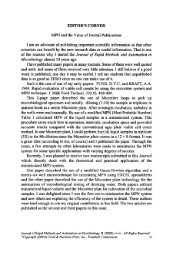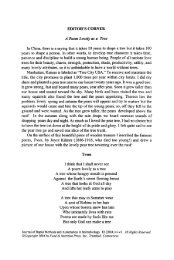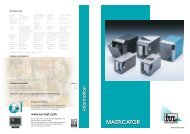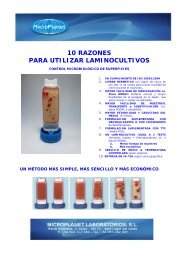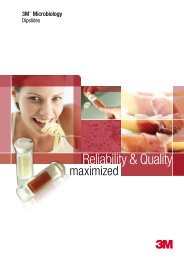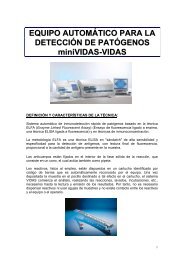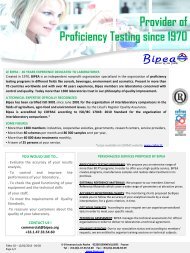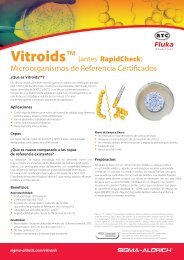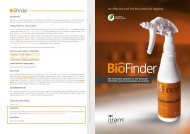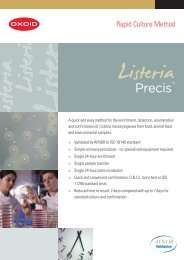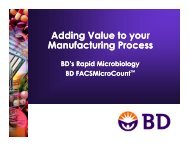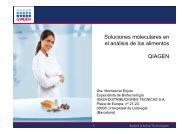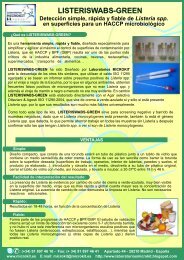Sistemas Path-Check Hygiene
Sistemas Path-Check Hygiene
Sistemas Path-Check Hygiene
Create successful ePaper yourself
Turn your PDF publications into a flip-book with our unique Google optimized e-Paper software.
Detección rápida de patógenos en superficies<br />
La detección de patógenos en las industrias agroalimentarias debe considerarse como un<br />
componente imprescindible de las Buenas Prácticas de Fabricación y un componente integral de cualquier<br />
plan de APPCC (Análisis de Peligros y Puntos de Control Críticos). Por ello, la necesidad de disponer de un<br />
método coste-efectivo, fácil de utilizar, rápido y preciso para el análisis ambiental se ha convertido en una<br />
prioridad en la industria alimentaria.<br />
Microgen Biproducts Ltd ha satisfecho esta necesidad desarrollando un rango de sistemas de<br />
detección de patógenos ambientales: los <strong>Sistemas</strong> <strong>Path</strong>-<strong>Check</strong> Higiene. Estos sistemas cumplen con<br />
todos los requisitos de los Estándares ISO para el análisis ambiental (ISO 18593:2004 (E)) por medio de la<br />
utilización de hisopos prehumedecidos para el análisis de superficies, junto a un caldo de detección<br />
cromogénico específico en el cual se colocan los hisopos y se incuban a una temperatura adecuada.<br />
El rango de sistemas <strong>Path</strong>-<strong>Check</strong> Higiene está disponible para el análisis de 3 tipos de organismos<br />
diferentes: Salmonella, Listeria y Coliformes. Sin embargo, los tres sistemas utilizan el mismo principio de<br />
análisis. Las bacterias se recuperan de la superficie de la maquinaria de fabricación o producción de<br />
alimentos utilizando un hisopo prehumedecido, el cual es capaz de neutralizar los detergentes y<br />
desinfectantes que se emplean con más frecuencia. El hisopo con la muestra se transfiere a un medio<br />
específico para cada microorganismo (los hisopos tienen un punto de ruptura por el cual pueden partirse<br />
fácilmente para colocarlos directamente en el medio de crecimiento). Los medios de análisis se incuban<br />
entonces a 35-37ºC durante 18-24 horas para Coliformes y Salmonella, y a 28-30ºC durante 24-48 horas<br />
para Listeria (si se incuba el <strong>Path</strong>-<strong>Check</strong> Listeria a 35-37ºC pueden aparecer falsos positivos en algunos<br />
casos). Si el microorganismo objetivo específico se encuentra presente en los hisopos que contienen la<br />
muestra, el crecimiento bacteriano provocará un cambio en el color del medio.<br />
Los kits <strong>Path</strong>-<strong>Check</strong> ofrecen los siguientes beneficios:<br />
• Altos niveles de sensibilidad (
MICROGEN BIOPRODUCTS LTD<br />
Salmonella Listeria Coliformes<br />
PATH-CHEK HYGIENE PATHOGEN<br />
SYSTEM<br />
TEST RÁPIDOS PARA LA DETECCIÓN DE<br />
BACTERIAS PATÓGENAS EN SUPERFICIES<br />
DE TRABAJO O MAQUINARIA<br />
• ALTOS NIVELES SE SENSIBILIDAD (
A medida que los fabricantes y productores de alimentos se dan cuenta de la importancia del control<br />
de la higiene microbiológica ambiental como parte de unas buenas prácticas de fabricación en la<br />
industria alimentaria, la necesidad de un método coste-efectivo, fácil de utilizar, rápido y preciso para<br />
el análisis ambiental ha crecido en importancia. Microgen Bioproducts Ltd ha satisfecho esta necesidad<br />
desarrollando un nuevo rango de sistemas de detección de patógenos ambientales: los sistemas<br />
<strong>Path</strong>-Chek Higiene. Estos sistemas cumplen todos los requisitos de los Estándares ISO para el<br />
análisis ambiental (ISO 18593:2004 (E)) por medio de la utilización de hisopos prehumedecidos para<br />
el análisis de superficies, junto a un caldo de detección cromogénico específico de organismos en el<br />
cual se colocan los hisopos y se incuban a la temperatura adecuada.<br />
El rango de los sistemas <strong>Path</strong>-Chek Higiene consiste en análisis para 3 tipos de organismos: Listeria,<br />
Coniformes y Salmonella.<br />
Los tres sistemas utilizan un el mismo principio de análisis. Las bacterias se recuperan de la superficie<br />
de maquinaria de fabricación o producción de alimentos utilizando un hisopo prehumedecido, el<br />
cual es capaz de neutralizar los detergentes y desinfectantes que se emplean con más frecuencia. El<br />
hisopo con la muestra se transfiere a un medio específico para organismos (los hisopos tienen un<br />
punto de rotura por el cual pueden romperse fácilmente para colocarlos directamente en el medio<br />
de crecimiento). Los medios de análisis se incuban entonces a 35-37ºC durante 18-24 horas para<br />
Coliformes y Salmonella, y a 28-30ºC durante 24-48 horas para Listeria (si se incuba el <strong>Path</strong>-Chek<br />
Listeria a 35-37ºC, en algunos casos pueden aparecer falsos positivos). Si la bacteria objetivo específica<br />
se encuentra presente en los hisopos con la muestra, el crecimiento bacteriano provocará un<br />
cambio en el color del medio.<br />
Reacciones del test:<br />
Resultado para Coliformes: Positivo Negativo<br />
Resultados para Salmonella: Positivo Negativo<br />
Resultado Para Listeria: Positivo Negativo<br />
Swabs Microgen <strong>Path</strong>-Chek<br />
Higiene<br />
Formato: 100 swabs<br />
Conservación: Temp. ambiente<br />
025040100 (PCS-100)<br />
<strong>Path</strong>-Chek <strong>Hygiene</strong> <strong>Path</strong>ogen Detection<br />
Broth<br />
Formato: 100 ud.<br />
Conservación: 2-8°C<br />
Listeria 025039100 (PCS-080)<br />
Salmonella 025038100 (PCS-020)<br />
Coliformes 025037100 (PCS-010)<br />
2007-01
All internationally accepted standards for the isolation of Listeria spp. and L. monocytogenes from food samples<br />
recommend that all pre-enrichment and sometimes enrichment broths are incubated at 30°C rather than 35 - 37°C, (ISO<br />
11290 -1:1996, AS/NZS 1766.2.16: 1998, US FDA BAM/AOAC). One rationale for this initial lower incubation temperature is<br />
that Listeria spp. and in particular L. monocytogenes may not grow well in these media when incubated at 35 - 37°C and that<br />
in cases of mixed populations of Listeria spp., L. innocua may in fact overgrow L. monocytogenes at this incubation<br />
temperature but not at 30°C.<br />
A study was performed in an independent Public Health Food Testing Laboratory to ascertain the potential effects of<br />
incubating the <strong>Path</strong>-Chek <strong>Hygiene</strong> Listeria at 30°C rather than 35 - 37°C. This study was performed using a range of<br />
environmental samples taken from a local food manufacturer who is known to have Listeria in their work environment.<br />
In this trial each sample area was swabbed in triplicate, one swab was processed in <strong>Path</strong>-Chek <strong>Hygiene</strong> at an incubation<br />
temperature of 37°C, a second swab was processed similarly, but incubated at 30°C. The third swab was transferred into<br />
10ml UVM broth which was incubated for 48 hours at 30°C after which a sample of the broth was examined for the presence<br />
of Listeria spp. using an AOAC Approved Listeria EIA.<br />
All <strong>Path</strong>-Chek Listeria tests were subcultured onto Oxford Agar and incubated at 37°C for 48 hours and examined for<br />
colonies resembling Listeria spp. after 48 hours incubation. All suspicious colonies were Gram stained and subjected to<br />
appropriate identification tests to include or exclude Listeria spp.<br />
RESULTS<br />
Technical Bulletin No. 108<br />
Improved Specificity of <strong>Path</strong>-Chek <strong>Hygiene</strong><br />
Listeria<br />
A total of 35 environmental samples were examined for the presence of Listeria spp.. Three samples were found by all 3<br />
methods to contain L. monocytogenes, <strong>Path</strong>-Chek <strong>Hygiene</strong> Listeria was able to detect the presence of these 3 positive<br />
samples after only 24 hours incubation, more than 24 hours earlier than the testing laboratories control method (Table 1.).<br />
Although the results of this trial did not demonstrate any differences between the isolation of Listeria spp. in the 3 positive<br />
samples, this investigation did demonstrate a significant decrease in the number of false positive results in the <strong>Path</strong>-Chek<br />
<strong>Hygiene</strong> Listeria tests that were incubated at 30°C when compared to those incubated at 37°C.<br />
After 24 hour incubation at 30°C, only 2 samples produced false positive results, whilst the same samples incubated at 37°C<br />
produced 9 false positive results. After a total of 48 hours incubation, the tests incubated at 37°C produced 13 false positive<br />
results, whilst those incubated at 30°C produced only 6 false positive tests. 6 positive results at 48 hours at both 30°C and<br />
37°C, showed no growth once sub-cultured on the Oxford Agar plates, producing no identification as the organism in the<br />
broth did not grow on the Oxford Agar plates.<br />
Based on this investigation it is clear optimum results for <strong>Path</strong>-Chek <strong>Hygiene</strong> Listeria are obtained at 30°C and should be<br />
examined for a colour change indicative of the presence of Listeria spp. after both 24 and 48 hours.<br />
Microgen Bioproducts Ltd, 1 Admiralty Way, Camberley, Surrey GU15 3DT. Tel +44 (0) 1276 600081, Fax +44 (0) 1276 600151<br />
www.microgenbioproducts.com
<strong>Path</strong> Chek Listeria Typical <strong>Path</strong> Chek Listeria Typical EIA<br />
30C Incubation colonies on 37C Incubation colonies on result<br />
Esculin reaction Oxford Agar Identification Esculin reaction Oxford Agar Identification Identification<br />
Swab Source 24hr 48hr 24hr 48hr<br />
1. Floor near sliding door - + No GPC + + No GPC -<br />
2. Drain in holding room + + No Growth + + No Growth -<br />
3. Rubber on sliding door + + No GPC + + No GPC -<br />
4. Production room drain - + No GPB + + No Growth -<br />
5. Production room floor - - - + No GPC -<br />
6. Floor under pump - - - - -<br />
7. Floor in corner - - + + No Growth -<br />
8. Floor mat near pack line - - - + No Growth -<br />
9. Coolroom floor - - + + No GPB -<br />
10. Blast room sliding door - - + + Yes GPB -<br />
11. Wheels on pump frame - - + + No Growth -<br />
12. Wheels on pump track 1 - - - - -<br />
13. Wheels on pump track 2 - - - - -<br />
14. Wheels on pump track 4 - - - - -<br />
15. Wheels on pump track 3 + + Yes L. monocytogenes + + Yes L. monocytogenes + L. monocytogenes<br />
16. Wheels on pump 2 + + Yes L. monocytogenes + + Yes L. monocytogenes + L. monocytogenes<br />
17. Wheels on pump 3 + + Yes L. monocytogenes + + Yes L. monocytogenes + L. monocytogenes<br />
20. Chiller slide door - - - - -<br />
26. Open drain - - - - -<br />
27. Chiller slide door - - - - -<br />
28. Underneath bench - - - - -<br />
29. Floor near pallet - - - - -<br />
30. Drain near foot bath - - - + No GPB -<br />
31. Drain in batching area - + No Growth - + No Growth -<br />
32. Fllor in blast chiller - - - - -<br />
33. Wall in thawing room - - - - -<br />
34. Door in thawing room - + No Growth + + No Growth -<br />
35. Door in chiller - - - - -<br />
Table 1. Comparison of <strong>Path</strong>-Chek <strong>Hygiene</strong> Listeria tests incubated at 30°C and 37°C and control EIA System for<br />
environmental samples.<br />
GPC = gram-positive cocci, presumptively identified as E. faecalis<br />
GPB = gram-positive bacilli, presumptively identified as Bacillus spp.<br />
Microgen Bioproducts Ltd, 1 Admiralty Way, Camberley, Surrey GU15 3DT. Tel +44 (0) 1276 600081, Fax +44 (0) 1276 600151<br />
www.microgenbioproducts.com



